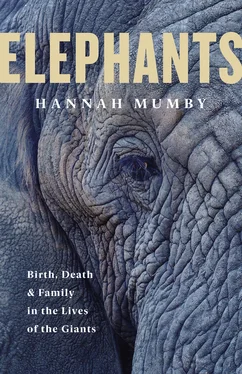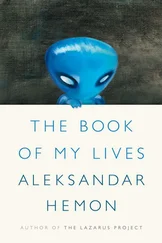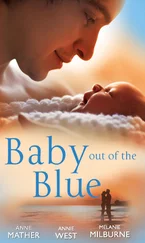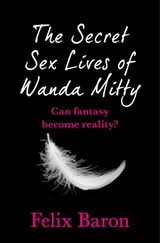‘Save The Elephants,’ I told them.
The representatives arrived half an hour later: two smiling young men, Jerenimo and Benjamin. I felt uncomfortable that I must have been several years older than them and asked myself if I was being ridiculous by following them, but I realised my alternatives were non-existent. They didn’t seem the least bit uncomfortable. On the contrary, they were grinning at me. We chatted in the vehicle as we bumped along the sandy roads. My overwhelming first impression of Samburu was of toasty orange sand and thorns. Thorns so impressive that I didn’t want to think of stepping on one. I retreated into my safe space, scientific knowledge, and reflected that plants must have to strongly defend themselves against plant-eating animals to evolve those five-centimetre protective prongs. While I was lost in my thoughts, Jerenimo stopped the car. He was still smiling.
‘We have to walk the rest of the way.’
I looked at the river that he had parked beside and the remains of the bridge spanning it. Benjamin told me that the river had flooded earlier in the year and destroyed the bridge and much of the camp. It had plenty of crocodiles, so we were better off climbing over what was left of the old bridge. Gallantly, Jerenimo and Benjamin took my bags. I wished I had a better sense of balance, another thing I should have been focusing on instead of all that reading. I began coaching myself. Hannah, this is fieldwork. You said you wanted to do it. You want to understand elephants? You need to live in a tent, go on those dirt roads and climb over this bridge! I convinced myself that I was not an attractive meal to a crocodile, without giving the idea the scientific scrutiny it might have merited at other times. I climbed clumsily up the side of the bridge and peeked over the top.
Baboons!
The flashing canine teeth of the larger male baboons impressed me much more in the flesh than I had expected. I knew they were mainly for display, but I ducked back down. Jerenimo and Benjamin put their knowledge of animal behaviour into action and pulled themselves up to their full height, puffing out their chests, clapping their hands and shouting out loud. The baboons duly dispersed and I made a mental note to behave more like a baboon when I was around baboons.
A few days later, I had settled into camp life. Despite having been devastated by the flood that had destroyed the ‘Baboon Bridge’ just five months earlier, the camp was tidy, well-equipped and functional. The days quickly took on a form and rhythm that became familiar, and I realised that I could more easily adapt to living anywhere than I had imagined. I was staying in a tent underneath a corrugated iron roof, to protect me from the vervet monkey excrement dropping from the tree when I woke in the morning. I had an orange plastic bucket to wash in, which a small antelope with a spring in its step known as a klipspringer had also taken to using as a fresh water supply. I would go to the water pump every morning and fill up a transparent bottle. I would leave this in the centre of the camp, exposed to the sun, in order to warm the water for my afternoon bucket shower. I became used to the long drop (even thankful for the breeze it created) and to making sure I put the rope across the entrance so that people knew I was in there. I played checkers using the tops from beer bottles; the gold Tusker brand tops got me thinking of the symbolic power elephants have over us. As well as the curious klipspringer, I met some of the other animals that frequented the camp: a wizened pair of hornbills, still striking in their senescence with white and black feathers and curved orangey-yellow beaks; a band of mongooses hunting by the dining area. The troop of baboons I had first met on the bridge appeared calmer as they traversed the slope next to our breakfast table undisturbed. There was a group of rock hyraxes, fluffy mammals that look a bit like oversized guinea pigs but are actually some of the closest living relatives of elephants. They slept a lot, and sometimes took a break from basking in the sun to investigate the bags of flour in the food store. But however charming these characters were, I hadn’t yet seen an elephant. After all, that’s why I had come all the way to Kenya.
The following morning at breakfast, I got much more than chai, toast and honey: my first wild elephant sighting. To this day, I can’t imagine a better gateway to watching elephants. I can’t begin to explain how lucky I was that it happened when I was on foot and in the camp. The former because it allowed me to sense the scale of the elephant in front of me and my own fragility, which is just not possible in a vehicle. And the latter because I was familiar enough with the camp not to let the experience terrify and overwhelm me. An old male elephant, Yeager, had come to investigate the old collars that had been worn by elephants to mount the tracking devices. The delicacy with which he handled these bulky and decaying pieces of abandoned equipment touched me. He explored them with the tip of his trunk and turned them gently, detecting the scent of their former wearers, faded over time. I remember his face so clearly. It was wide above the trunk, as happens to males with age, with deep horizontal wrinkles traversing the front of his face. Either side, his eyes were looking downwards, the direction of his gaze emphasised by the dramatically long and spindly eyelashes shading them. His tusks were thick at the base, another sign of his age. His right tusk splayed out to the side and formed a stubby but impressive point, while the left one had a messy jagged break about 5 centimetres down from his lip line, exposing the layers of hard tissue and giving him a rakish, rugged appearance.
Yeager moved so slowly, but with so much power and intention. I watched him pull up grass with the tip of his trunk, flick the trunk back and forth to remove the dust from the roots and place the grass in his mouth, chewing methodically and rhythmically. I don’t know how long I watched him for. It could have been minutes or hours, but it didn’t matter because it was on his time. The pace of my perception slowed to match his, and with it some of the urgency of this world diminished: the irresistible urge to push forward, even when I didn’t know why I was doing it. As he eventually eased his way out of the camp, he paused to defecate, dropping five balls of caramel-coloured dung. When he was safely out of the way, I walked over to where he had been, taking time to look at his footprints in the sand, with their crisscrossing cracks like trails on a map. From the flat area at the back of his foot I could work out the direction in which he had been walking. I could see where he had rested his trunk on the ground, leaving a valley of ripples. I smelled his dung, grassy, warm and not the slightest bit repulsive. I squeezed it between my fingers, letting the green-yellow water run down my arm. There was life in that dung. I felt the barely digested plant material, gathered from kilometres away and deposited here; the potential for dung beetles to roll it away, or a frog to take up residence there, or the seeds in it to germinate. I thought of the worm eggs that I’d only later see under the microscope, and, smaller still, his DNA, the bacteria from his gut, the metabolised fragments of all his hormones. I saw him at once as more than the sum of his parts, a vital part of a system that was both much bigger and much smaller than him.
I had come to Kenya looking for a slow-living animal, a model on which to test my ideas. I laughed at myself for dismissing Iain as an elephant before I had met one myself. What Yeager gave me was the experience of feeling my own life slow down, when I watched him and his face being seared onto my soul. I knew I wanted to spend the rest of my life working with elephants. But for me, it wasn’t enough to watch in awe and appreciate. My love and science had collided again, just as they had done at the first life-history lecture I attended. Yeager raised more questions in me than he answered. The biggest scientific issue for me was that perhaps my theoretical framework had been too reductive: by considering individuals as the embodiment of their life-history landmarks, I had lost too much of their complexity. Although Yeager was alone, I saw so much interaction – the grass he ate, the collars he sniffed, that incredible dung he dropped. For me, this crystallised the fact that elephants in isolation from their environment make no sense. I knew elephants had startling parallels with humans in terms of their life history, but broadening what I could imagine, see, test and understand about them might reveal even more intriguing parallels and contrasts. I couldn’t study them the way I had originally intended, with elephants just as a model. By doing that I would limit them, limit Yeager because he was so much more. I had to understand what it was to be an elephant and try, in the limited and human way I could, to conduct my studies from that point of view. A big evolutionary, ecological puzzle like an elephant deserves more than just our fascination, it deserves our critical thinking. That way I could enhance both my experience of being human and my understanding of being human on every level, from the deeply personal to the scientifically challenging.
Читать дальше












